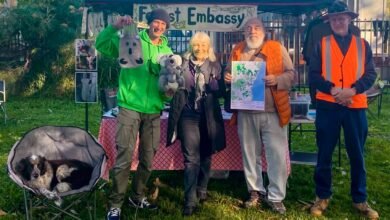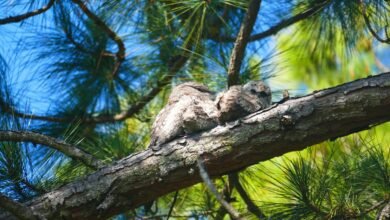Trees are good for us too
Trees have a wonderful independent existence that we should respect. But they also happen to be very useful to us. They provide oxygen (though much more comes from phytoplankton), food, medicine and raw materials. They also provide shade and windbreaks, cool their surroundings, mitigate flooding, and reduce air pollution and act as carbon sinks.
Trees are nearly always the answer.
Our ancestors lived in the arboreal world. The English naturalist Roger Deakin noted that we share our evolutionary processes, DNA and atoms with every tree, which he called the ‘fifth element’. When he was dying, he wrote, ‘To enter a wood is to pass into a different world in which we ourselves are transformed. It is no accident that in the comedies of Shakespeare, people go into the greenwood to grow, learn and change.’ [i]
We now have evidence for what we knew, that spending time with trees reduces stress, lowers blood pressure and improves the mood. Numerous studies show that walking or exercising in forests, or simply sitting in one reduces blood pressure and levels of the stress-related hormones cortisol and adrenaline. Any tree will do, but some trees are more remarkable than others.

Artists use and misuse trees
‘I think that I shall never see a billboard lovely as a tree. Perhaps, unless the billboards fall, I’ll never see a tree at all.’ Ogden Nash.[ii]
Artists like to paint trees.
Trees are beautiful and often a source of inspiration. John Ruskin was particular about depicting nature, about drawing trees. He complained of a tree by that great painter Nicolas Poussin: ‘It has no bark, nor roughness nor character of stem; its boughs do not grow out of each other, but are stuck into each other.’ [iii]
In 2003, the realist painter Lucien Freud hung John Constable’s ‘Study of the Trunk of an Elm Tree’ (c1824) unframed, at the entrance to an exhibition of his favourite works by Constable at the Grand Palais, Paris. It was never shown in his lifetime. Robert Macfarlane waxes lyrical about the work, ‘As Constable knew, with attention, with a particularity of looking, a world reveals itself in a tree’s bark. Lean in close to bark, and you will find a landscape which you might enter, through whose ravines and ridges you might make day-long journeys. Above all, perhaps, bark resembles a map.’[iv] An indigenous sense of the world maps the past into the present, the seen and unseen are mapped along songlines and through song, art, law and story.
Artists sometimes plant trees
Josef Beuys used an image of an oak tree on a postcard to announce his original, most famous and ambitious work ‘7000 Oak Trees’ in 1982, and wrote below the tree: ‘An Idea Takes Root’.
For documenta 7 1982, Beuys proposed a plan to plant 7000 oaks throughout the city of Kassel, each paired with a basalt stone. Several months prior to the opening of the exhibition, Beuys himself planted the first tree. 7,000 stones were piled on the lawn in front of the Museum Fridericianum. He wrote, ‘I believe that planting these oaks is necessary not only in biospheric terms, that is to say, in the context of matter and ecology, but in that it will raise ecological consciousness-raise it increasingly, in the course of the years to come, because we shall never stop planting.’ [v]
Planting site proposals were submitted by residents, neighbourhood councils, schools, etc. The result, according to Norbert Scholtz, offered significant opportunities for ‘occupying and utilizing ‘public’ open space socially.’[vi] Matthew Gandy notes that, ‘With 7,000 Oaks, Beuys had not only addressed contemporary ecological anxieties but had also tapped into nationalistic conceptions of German heritage as a wooded landscape.’[vii] As Beuys foretold, ‘Thus, 7000 Oaks is a sculpture referring to peoples’ life, to their everyday work. That is my concept of art which I call the extended concept or art of the social sculpture.’[viii]

Artists occasionally destroy trees, even sections of a forest
We have to be wary of aesthetic qualities alone. Finnish artist Antti Laitinen cut down a precise square of trees in a forest, ‘Forest Square’ (2013) for the Venice Biennale. He sorted all the materials, grasses, moss and even the top layer of soil into grids by the category of colour. He explained, ‘The role of nature . . . is to offer the raw material, to be the mirror that reflects whatever the artist has to express. In its quasi-scientific approach, Forest Square is a kind of experiment on de-mystifying nature. It does not regard forest mainly as a place containing a mystic aura, as something that revives the stressed mind or has this age-old existence beyond generations of people and has even been considered sacred not so long ago in the Finnish culture.’[ix] No mention of the insects that died or the displacement of fauna and flora.
I have to say that Laitinen’s grids are attractive and remind me of Allen Carlson’s defence of the aesthetic qualities of the new industrial agriculture (which has decimated wildlife): ‘Here intensity of color and boldness of line combine with scale and scope to produce landscapes of breathtaking formal beauty: great checkerboard squares of green and gold, vast rectangles of infinitesimally different shades of grey . . . When viewed from high land or a low flying plane such landscapes match the best of geometrical painting in power and drama.’ [x]
Like landscape, trees have amazing formal properties that art can reveal. The Scottish artist Anya Gallaccio reconstructed a weeping cherry (accidentally killed) for her piece ‘One Art’ in New York. She felled and dismantled the 15-metre tree then reconstructed it with all the engineering required to support it clearly visible. ‘In one art, Gallaccio’s aesthetic act is to move the tree from its normal outdoor environment to an urban industrial building adapted as an exhibition space. Yet the process of disassembling and rebuilding the tree transforms it – drawing attention to the extraordinary formal and structural properties of the tree.’[xi]
Art cannot compete
‘In 2012, Qatar’s royal family bought one of five Paul Cezanne paintings titled The Card Players for approximately $250 million. By way of contrast, a 160-acre plot of hardwood forest in Forest County Wisconsin is now for sale for $250,000. The painting is roughly three feet high by four feet wide. The 160-acre forest is 880 square yards or twice the size of the area around Walden Pond that so inspired Henry David Thoreau and twice the size of Aldo Leopold’s Sauk County farm. The painting sold for a price one thousand times that of the forest. The forest is approximately 500,000 times larger than the painting. Many factors other than aesthetic ones affect the price of both paintings and forests; nonetheless, the difference is startling when you consider the variety, quantity, and quality of aesthetic experience the forest is capable of providing compared to the painting.’ Dennis Vickers.[xii]
Landscape photographers Diane Cook and Len Jenshel spent over two years tracking down one of the world’s most remarkable trees. They write, ‘Trees can live without us, but we cannot live without them. It is our hope that by paying tribute to their beauty, significant stories, and all the wisdom they have to impart, we can appreciate not only their role in our past, but also how crucial they are to our future.’[xiii]
I am a poet and well aware of another poet’s concern ‘Talk talk talk and out come the sounds and like poetry they change nothing but we talk talk talk anyway and we mistake the sounds for meaning or action, and the trees stand there silently and we just talk.’[xiv] Talk is not enough.
Novelist Richard Powers advises: ‘Go outside and marvel at a tree. And, if you can’t find one, plant one. We can make a difference if we start NOW.’[xv] We also need to band together, taking collective action by supporting Green groups like FEA, writing to, or even better, talking to politicians, using what skills we have to contribute to the struggle to save the world we belong to.
Ref:
[i] Roger Deakin, Wildwood: A Journey Through Trees, Hamish Hamilton, 2007.
[ii] Ogden Nash, ‘Song of the Open Road’, New Yorker, October, 1932. He is parodying Joyce Kilmer’s, ‘I think that I shall never see. / A poem lovely as a tree.’ from ‘Trees’, Poetry No 5, August, 1913.
[iii] John Ruskin, Modern Painters Vol IV, 1856.
[iv] Robert Macfarlane, Memory Maps: ‘Elm’, V&A, no date,
http://www.vam.ac.uk/content/articles/m/memory-maps-elm-by-robert-macfarlane/
[v] Lynne Cooke 7000 Oaks http://web.mit.edu/allanmc/www/cookebeuys.pdf
[vi] See Norbert Scholz, ‘Joseph Beuys-7000 Oaks in Kassel’, Anthos (Switzerland), no.3, 1986, p34.
[vii] Matthew Gandy, ‘Contradictory Modernities: Conceptions of Nature in the Art of Joseph Beuys and Gerhard Richter’, Annals of the Association of American Geographers, Vol. 87, No. 4, Dec. 1997. ‘Running through Beuys’s work we find a constant tension between nature and reason: nature is used time and again as a bulwark against Enlightenment rationality. His fusion of radical ecologism and postmodern aesthetics is not
only predicated on the blurring of boundaries between high art and popular culture but also lacks any meaningful distinction between humankind and the rest of nature.’
[viii] Norbert Scholz, 1986, p32.
[ix] Sanna Lehtinen, ‘Falling Tree’ – Contemporary Artistic Interpretations of Nature’, in Creative Processes in Art, eds. Ana Rita Ferreira, Ana Nolasco, Lisbon: University of Lisbon, 2014.
[x] Allen Carlson, Aesthetics and the Environment, Routledge,2002, p185-6.
[xi] Anya Gallaccio: one art, Jan 8–Apr 3, 2006. https://www.sculpture-center.org/exhibitions/3051/one-art. She is a Goldsmiths graduate who took part in Damien Hirst’s famous 1988 show Frieze, that launched YBA (Young British Artists)’.
[xii] Dennis Vickers, ‘Aesthetic experience of the Forest’, Journal of Aesthetic Education, Vol 51:1, Spring, 2017.
[xiii] Diane Cook and Len Jenshel, Wise Trees, Abrams, 2017.
[xiv] Paul Kingsnorth, Savage Gods, Two Dollar Radio, 2019
[xv] Richard Powers, interview with Lynn Neary, ‘Novelist Richard Powers Finds New Stories Deep In Old Growth Forests’, NPR, April 19, 2018. Discussing his novel ‘The Overstory’, 2018. Our garden had one tree when we moved in eleven years ago, now it has over 150, roughly half are self-seeded.



